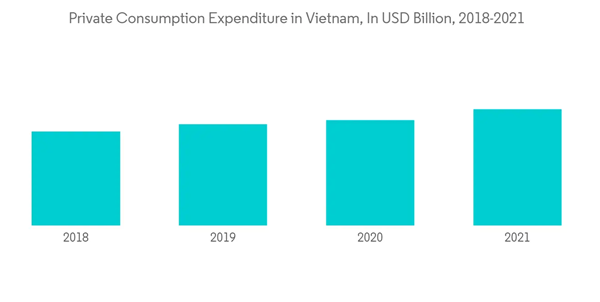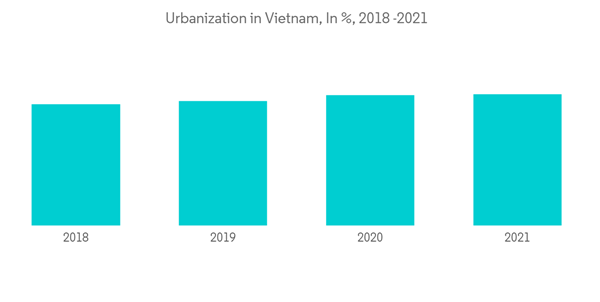The Vietnam Retail Market size is estimated at USD 276.37 billion in 2024, and is expected to reach USD 488.08 billion by 2029, growing at a CAGR of 12.05% during the forecast period (2024-2029).
While the COVID-19 crisis impact was felt globally, Vietnam's effective control of the pandemic led to the recovery of retail sales of consumer goods and services in 2020's final months. The growth rate, while remaining lower compared to the 12.7% recorded the previous year, was an encouraging sign for the business community amid the global retail market suffering a plunge in revenue during the pandemic. Retail sales growth rate by year-end was due to retailers and shopping malls offering sales promotion programs to stimulate domestic consumption.
Vietnam is seeing ongoing urbanization and evolving demand trends among young urban consumers to drive strong growth in modern retailing channels such as departmental stores and the rapid expansion of e-commerce. Indeed, the growing influence of such factors can be seen in the emergence of formats such as mini supermarkets, which target the demand for grocery shopping that fits into the flow of busy urban lifestyles.
Modern retail outlets offer private brands/products that can be exclusively purchased in their stores. Supermarkets offer products that are better suited for the daily needs of the average consumer. Food products, non-food products, and home appliances are also offered in supermarkets, which makes shopping easier, as they offer everything needed for the customers under one roof. To further improve the shopping experience, some stores have in-house bakeries and cafés where consumers can hang out and enjoy themselves with family or friends.
This product will be delivered within 2 business days.
While the COVID-19 crisis impact was felt globally, Vietnam's effective control of the pandemic led to the recovery of retail sales of consumer goods and services in 2020's final months. The growth rate, while remaining lower compared to the 12.7% recorded the previous year, was an encouraging sign for the business community amid the global retail market suffering a plunge in revenue during the pandemic. Retail sales growth rate by year-end was due to retailers and shopping malls offering sales promotion programs to stimulate domestic consumption.
Vietnam is seeing ongoing urbanization and evolving demand trends among young urban consumers to drive strong growth in modern retailing channels such as departmental stores and the rapid expansion of e-commerce. Indeed, the growing influence of such factors can be seen in the emergence of formats such as mini supermarkets, which target the demand for grocery shopping that fits into the flow of busy urban lifestyles.
Modern retail outlets offer private brands/products that can be exclusively purchased in their stores. Supermarkets offer products that are better suited for the daily needs of the average consumer. Food products, non-food products, and home appliances are also offered in supermarkets, which makes shopping easier, as they offer everything needed for the customers under one roof. To further improve the shopping experience, some stores have in-house bakeries and cafés where consumers can hang out and enjoy themselves with family or friends.
Vietnam Retail Market Trends
Rapid Growth in Consumer Spending is a Driving Factor
Vietnam's disposable income per capita is expected to grow quickly and reach USD 3,062 in 2023. Vietnam's real household spending increased 8.3% to USD 121.3 billion in 2021, compared to USD 112.1 billion in 2019 . The private consumption rate is also high, more than 67% of the GDP. This is the second highest in the region, behind the Philippines (73.8%) and ahead of Malaysia and Indonesia (57.0% and 57.3%, respectively).Low Urbanization with High Potential for Growth
Vietnam's urbanization rate is still low when compared across the region, at 37% of the population, compared with rates between 47% and 76% in other Southeast Asian countries. This represented an area of high potential and expected growth. In fact, the Vietnamese urban population is expected to register a CAGR of about 3% in the forcasted period, while this growth rate is between 1% and 2 % for Indonesia, Malaysia, the Philippines, and Thailand. Analysis of urbanization rates in comparable Southeast Asian countries indicates that the early stage of urbanization is likely to be rapid. Vietnam's growth follows a similar trajectory, as urbanization is likely to reach 55% in 2030.Vietnam Retail Industry Overview
The Vietnam market for Retail is competitive, owing to the presence of large domestic players, where domestic companies have gained preference over multinationals due to their strong market power. The top companies use new product development, merger, expansion, acquisition, and partnership as strategic tactics to increase their brand presence among customers. It has major players Saigon Co. Op, Central Group, AEON group, Vin Group, and Lotte Mart.Additional Benefits:
- The market estimate (ME) sheet in Excel format
- 3 months of analyst support
This product will be delivered within 2 business days.
Table of Contents
1 INTRODUCTION
4 MARKET INSIGHTS AND DYNAMICS
5 MARKET SEGMENTATION
6 COMPETITIVE LANDSCAPE
Companies Mentioned (Partial List)
A selection of companies mentioned in this report includes, but is not limited to:
- Saigon Co.op
- Central Group
- AEON
- VinGroup
- Lotte
- 7-Eleven
- E-Mart Inc.
- Auchen
- Mega Mart
- Mobile World*
Methodology

LOADING...










